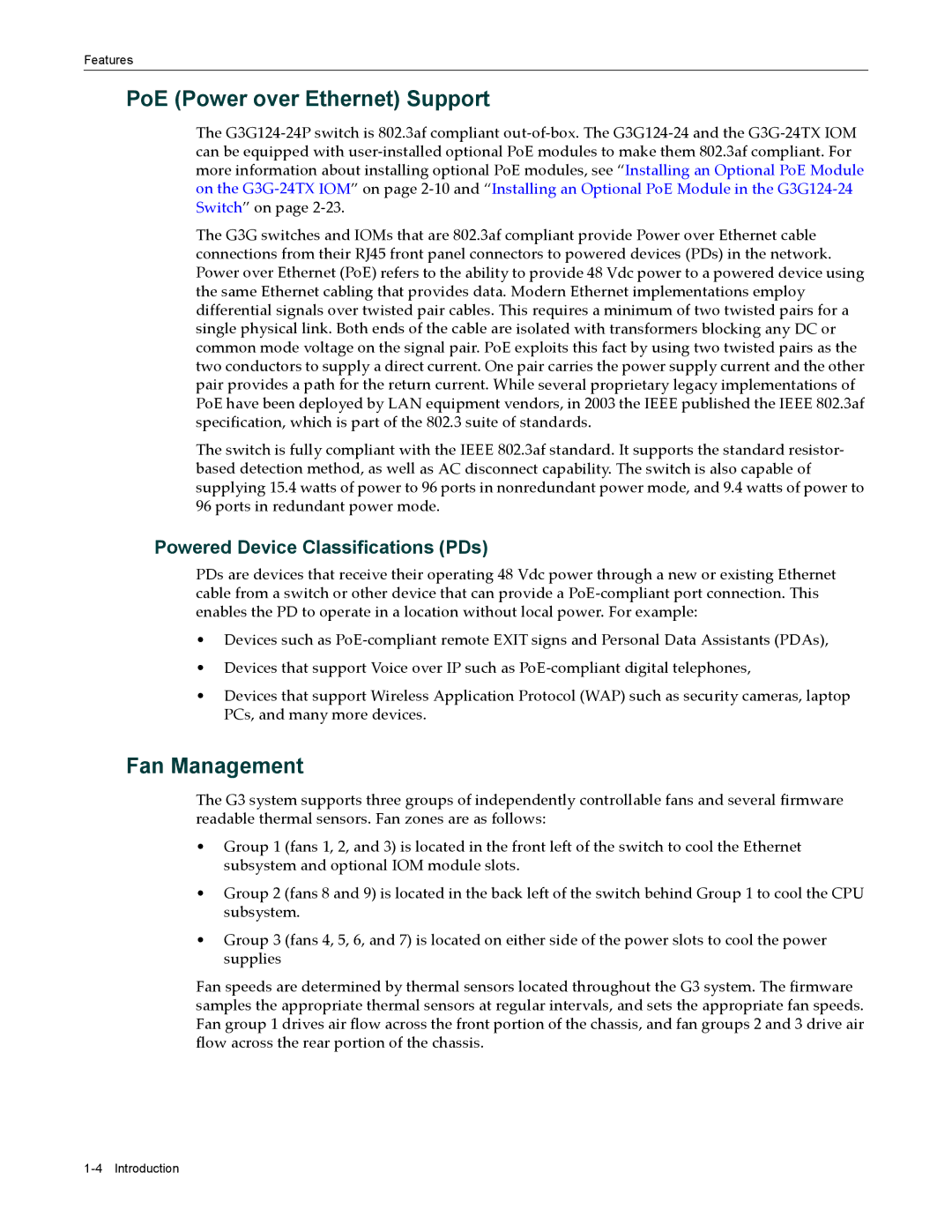Features
PoE (Power over Ethernet) Support
The G3G124‐24P switch is 802.3af compliant out‐of‐box. The G3G124‐24 and the G3G‐24TX IOM can be equipped with user‐installed optional PoE modules to make them 802.3af compliant. For more information about installing optional PoE modules, see “Installing an Optional PoE Module on the G3G‐24TX IOM” on page 2‐10 and “Installing an Optional PoE Module in the G3G124‐24 Switch” on page 2‐23.
The G3G switches and IOMs that are 802.3af compliant provide Power over Ethernet cable connections from their RJ45 front panel connectors to powered devices (PDs) in the network. Power over Ethernet (PoE) refers to the ability to provide 48 Vdc power to a powered device using the same Ethernet cabling that provides data. Modern Ethernet implementations employ differential signals over twisted pair cables. This requires a minimum of two twisted pairs for a single physical link. Both ends of the cable are isolated with transformers blocking any DC or common mode voltage on the signal pair. PoE exploits this fact by using two twisted pairs as the two conductors to supply a direct current. One pair carries the power supply current and the other pair provides a path for the return current. While several proprietary legacy implementations of PoE have been deployed by LAN equipment vendors, in 2003 the IEEE published the IEEE 802.3af specification, which is part of the 802.3 suite of standards.
The switch is fully compliant with the IEEE 802.3af standard. It supports the standard resistor‐ based detection method, as well as AC disconnect capability. The switch is also capable of supplying 15.4 watts of power to 96 ports in nonredundant power mode, and 9.4 watts of power to 96 ports in redundant power mode.
Powered Device Classifications (PDs)
PDs are devices that receive their operating 48 Vdc power through a new or existing Ethernet cable from a switch or other device that can provide a PoE‐compliant port connection. This enables the PD to operate in a location without local power. For example:
•Devices such as PoE‐compliant remote EXIT signs and Personal Data Assistants (PDAs),
•Devices that support Voice over IP such as PoE‐compliant digital telephones,
•Devices that support Wireless Application Protocol (WAP) such as security cameras, laptop PCs, and many more devices.
Fan Management
The G3 system supports three groups of independently controllable fans and several firmware readable thermal sensors. Fan zones are as follows:
•Group 1 (fans 1, 2, and 3) is located in the front left of the switch to cool the Ethernet subsystem and optional IOM module slots.
•Group 2 (fans 8 and 9) is located in the back left of the switch behind Group 1 to cool the CPU subsystem.
•Group 3 (fans 4, 5, 6, and 7) is located on either side of the power slots to cool the power supplies
Fan speeds are determined by thermal sensors located throughout the G3 system. The firmware samples the appropriate thermal sensors at regular intervals, and sets the appropriate fan speeds. Fan group 1 drives air flow across the front portion of the chassis, and fan groups 2 and 3 drive air flow across the rear portion of the chassis.
